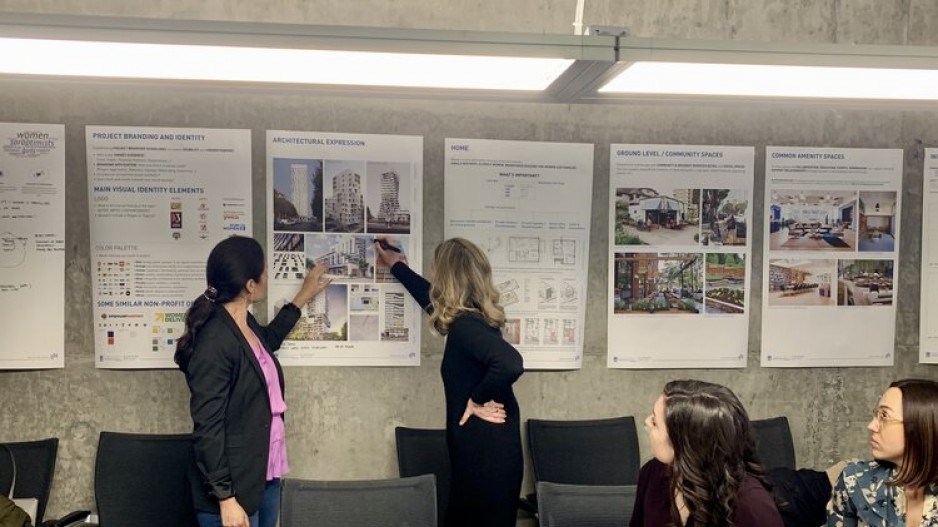For much of Carla Guerrera’s career in real estate development, she was the only woman at the boardroom table.
Building up the visibility of women and gender minorities in construction has been a goal for Guerrera – as well as for other female leaders – for much of her career, she said.
Greater urgency has been placed on encouraging underrepresented groups to work in construction due to С����Ƶ’s ongoing and looming skilled labour shortage. The result is a push for more education, mentorship and institutional change to support these efforts, according to those who spoke to BIV.
“I really have mostly had male bosses and male role models for most of my career, and there’s really been a lack of visibility of women leaders in the development and construction sectors and a lack of visibility of role models that are women. It is highly male dominated in both the construction and development sectors,” said Guerrera, who is the founder and CEO of Purpose Driven Development and has 20 years of experience in real estate development.
It’s not that women don’t have the skills, tenacity or determination to lead complex development projects, she said. It’s that they aren’t given the opportunity to do so.
Those who spoke to BIV said that problems persist in construction and development when it comes to family planning, the visibility of female leaders and mentors, sanitation facilities and culture.
Women represent 4.5 per cent of the construction trades workforce in С����Ƶ This accounts for 7,376 women in trades, a figure that has fallen by two per cent over the last four years, according to October 2023 data from the С����Ƶ Construction Association.
“The representation is not as significant as we would hope, especially with the [skilled labour shortage] and the fact that construction can provide a good career for women, men, anyone underrepresented and otherwise, there’s opportunity there,” said Jeannine Martin, president of the Vancouver Regional Construction Association (VRCA).
“When we think about women and inclusion in construction, it’s a slow-moving process.”
Though change may be slow going, female representation in the industry has improved “significantly,” said Brenda Gilbert, the executive vice-president at Scott Construction Group.
“Overall, the industry is moving towards a more collaborative way of building construction, and I think that can attract women,” she said.
Building for women, by women
One example of women pushing for a more collaborative approach in construction is the all-female development team working on a Soroptimist International of Vancouver project, for which Purpose Driven Development is the development lead.
The 13-storey project will provide 135 units of different sizes for senior women, women-led families and workforce women, according to Purpose Driven Development.
“The innovative part of this project, that makes it the first of its kind in North America, is that we’re delivering a project that’s going to provide affordable rental housing for women, by an all-woman team,” said Guerrera, adding that there are approximately 25 women on the development team. Not all of the construction positions are filled by women.
“Every single discipline that we hired on the project – from the land surveyor to the architect and all of the engineers – have all been women.”
The project aims to take a “gender-based look” at what women need in housing while also working to build capacity for women in the development and construction industry, according to Soroptimist International of Vancouver.
The site is located at West 13th Avenue and Cambie Street. The site area is 14,520 square feet and currently includes an aging two-storey rental building. The new project will feature a mix of units ranging in size from studios to three-bedroom units, along with a shared garden and outdoor space, meeting and event space, parking and bicycle parking.
“Our vision in leading this project was to demonstrate the leadership of women across design, development and construction … and really showcasing them and demonstrating their capabilities as a way of drawing more people into these fields,” said Guerrera.
The project has received a Female Frontiers Award by World Architect News and has attracted the interest of the U.S. State Department, Guerrera said.
‘A game of inches’
While this all-female development team is an encouraging example of change in the industry, more work needs to be done, according to those who spoke to BIV.
Mentorship, apprenticeship and sponsorship programs were referenced as a valuable tool to help inspire women to join the construction workforce. However, Martin said that more needs to be done to ensure that women are represented in these roles and have the ability to support new female workers in the industry.
“It’s very difficult to identify the magic bullet or the thing that is providing the most success. I think that it’s a game of inches, getting those people into the field and then promoting them along and having them see a future,” said Martin.
Greater visibility is also needed in leadership roles.
“When women are in those leadership roles, it becomes a top-down way of creating that visibility that other women are looking for to move into those organizations or into those sectors,” said Guerrera.
“It also then allows those women to help use their experience to transform the cultures within those organizations to allow for more friendly cultures and environments for women to work, thrive and balance their careers with their families and achieve both of those goals.”
Gilbert said that the hybrid work model has helped provide more flexibility around child care. However, child-care and maternity programs are not as prevalent as they could be, she said.
Women who want to start families and may need maternity leave can be seen as a liability on projects with long timelines, said Guerrera.
Other changes, such as the С����Ƶ government’s new mandate for flush toilets on construction sites, are a step in the right direction. Both Gilbert and Martin said that while this is needed, the legislation does not mean the facilities will be sanitary.




